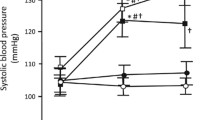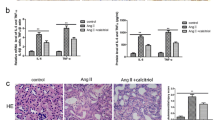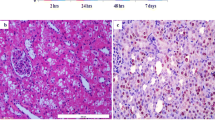Abstract
In this study, we investigated the protective effect of losartan as an AT1 receptor antagonist by evaluating the expression of apoptosis-regulatory genes that contribute to the progressive damage in the renal tubules of hyperoxaluric rats. Rats were divided into 4 groups of 10 each; control (C), ethylene glycol (EG), ethylene glycol + losartan (EG + L) and Losartan (L). For 4 weeks 0.8% EG, as a precursor for oxalate, was administered to EG and EG + L and losartan (300 mg/l) was administered to groups EG + L and L. Urine and blood samples were collected for biochemical determination. Bcl-2, bax, caspase-3 and TGF-beta 1 antibodies were used for immunohistochemistry. Apoptosis was determined by TUNEL method. A marked increase in urinary oxalate levels of the rats in EG and EG + L groups was found. In the EG group a diffuse amount of oxalate crystals into the tubular lumina and interstitium in the cortex was observed. In the EG group GBM thickening, interstitial fibrosis and tubular atrophy with infiltration of mononuclear cell findings reduced in the EG + L group were presented as well. In the EG group, immunoreactivity of TGF-beta 1 was increased in glomeruli and tubuli. In the EG + L group, immunoreactivity of TGF-beta 1 was decreased compared to the EG group. Bax expression increased in the renal tubules of EG group and reduced in the EG + L group comparing to the control. In the EG + L group, the immunoreactivity of bcl-2 was increased in glomeruli. In EG + L treated group, number of caspase-3 immunopositive cells were decreased compared to all groups (P < 0.01). Apoptotic cells were increased in the EG-treated group compared to the other groups. Decreased apoptotic cell number was observed in the EG + L compared to the EG group (P < 0.01). Our findings suggest that losartan may provide a beneficial effect against tubulointerstitial damage and decrease renal tubular apoptosis caused by hyperoxaluria.



Similar content being viewed by others
References
Kok DJ, Khan SR (1994) Calcium oxalate nephrolithiasis, a free or fixed particle disease. Kidney Int 46:847–854
Toblli JE, Stella I, de Cavanagh E, Angerosa M, Inserra F, Ferder L (1999) Enalapril prevents tubulointerstitial lesions by hyperoxaluria. Hypertension 33:225–231
de Water R, Boevé ER, van Miert PPMC, Vermaire CP, van Run PRWA, Cao LC, de Bruijn WC, Schröder FH (1996) Pathological and immunocytochemical changes in chronic calcium oxalate nephrolithiasis in the rat. Scanning Microsc 10(2):577–590
de Water R, Noordermeer C, van der Kwast TH, Nizze H, Boevé ER, Kok DJ, Schröder FH (1999) Calcium oxalate nephrolithiasis: effect of renal crystal deposition on the cellular composition of the renal interstitium. Am J Kidney Dis 33(4):761–770
Miller C, Kennington L, Cooney R, Kohjimoto Yasou, Cao LC, Honeyman T, Pullman J, Jonassen J, Scheid C (2000) Oxalate toxicity in renal epithelial cells: characteristics of apoptosis and necrosis. Toxicol Appl Pharmacol 162:132–141
Kok DJ (1997) Intratubular crystallization events. World J Urol 15:219–228
Hockenbery DM, Oltvai ZN, Yin XM, Milliman CL, Korsmeyer SJ (1993) Bcl-2 functions in an antioxidant pathway to prevent apoptosis. Cell 75:241–251
Sarica K, Erbagci A, Yagci F, Bakir K, Erturhan S, Ucak R (2004) Limitation of apoptotic changes in renal tubular cell injury induced by hyperoxaluria. Urol Res 32(4):271–277
Turan T, Tuncay OL, Usubütün A, Yonguç T, Aybek Z, Atahan O (2000) Renal tubular apoptosis after complete ureteral obstruction in the presence of hyperoxaluria. Urol Res 28(4):220–222
Khan SR, Shevock PN, Hackett RL (1992) Acute hyperoxaluria, renal injury and calcium oxalate urolithiasis. J Urol 147(1):226–230
Rovin BH, Phan LT (1998) Chemotactics factors and renal inflammation. Am J Kidney Dis 31(6):1065–1084
Gilbert RE, Wu LL, Kelly DJ, Cox A, Wilkinson-Berka JL, Johnston CI, Cooper ME (1999) Pathological expression of renin and angiotensin II in the renal tubule after subtotal nephrectomy. Am J Pathol 155(2):429–440
Ruiz-Ortega M, Lorenzo O, Ruperez M, Egido J (2000) ACE inhibitors and AT1 receptor antagonists beyond the haemodynamic effect. Nephrol Dial Transpl 15(5):561–565
Toblli JE, Ferder L, Angerosa M, Inserra F (1999) Effects of amlodipine on tubulointerstitial lesions in normotensive hyperoxaluric rats. Hypertension 34(4 Pt 2):854–858
Böttinger EP (2007) TGF-beta in renal injury and disease. Semin Nephrol 27(3):309–320
Burdmann EA, Andoh TF, Nast CC, Evan A, Connors BA, Coffman TM, Lindsley J, Bennett WM (1995) Prevention of experimental cyclosporin-induced interstitial fibrosis by losartan and enalapril. Am J Physiol 269(4 Pt 2):F491–F499
Toblli JE, Ferder L, Stella I, Angerosa M, Inserra F (2001) Protective role of enalapril for chronic tubulointerstitial lesions of hyperoxaluria. J Urol 166(1):275–280
Toblli JE, Ferder L, Stella I, de Cavanagh EM, Angerosa M, Inserra F (2002) Effects of angiotensin II subtype 1 receptor blockade by losartan on tubulointerstitial lesions caused by hyperoxaluria. J Urol 168:1550–1555
Kalender B, Oztürk M, Tunçdemir M, Uysal O, Dagistanli FK, Yegenaga I, Erek E (2002) Renoprotective effects of valsartan and enalapril in STZ-induced diabetes in rats. Acta Histochem 104(2):123–130
Erensoy N, Yılmazer S, Oztürk M, Tunçdemir M, Uysal O, Hatemi H (2004) Effects of ACE inhibition on the expression of type IV collagen and laminin in renal glomeruli in experimental diabetes. Acta Histochem 106(4):279–287
Fehsel K, Kröncke KD, Kolb H, Kolb-Bachofen V (1994) In situ nick-translation detects focal apoptosis in thymuses of glucocorticoid- and lipopolysaccharide-treated mice. J Histochem Cytochem 42(5):613–619
Tunçdemir M, Ozturk M (2008) The effects of ACE inhibitor and angiotensin receptor blocker on clusterin and apoptosis in the kidney tissue of streptozotocin-diabetic rats. J Mol Histol 39(6):605–616
Thompson CS, Weinman EJ (1984) The significance of oxalate in renal failure. Am J Kidney Dis 4(2):97–100
Chevalier RL, Smith CD, Wolstenholme J, Krajewski S, Reed JC (2000) Chronic ureteral obstruction in the rat suppresses renal tubular Bcl-2 and stimulates apoptosis. Exp Nephrol 8(2):115–122
Miyazawa K, Suzuki K, Ikeda R, Moriyama MT, Ueda Y, Katsuda S (2005) Apoptosis and its related genes in renal epithelial cells of the stone-forming rat. Urol Res 33(1):31–38
Zhang G, Oldroyd SD, Huang LH, Yang B, Li Y, Ye R, El Nahas AM (2001) Role of apoptosis and Bcl-2/Bax in the development of tubulointerstitial fibrosis during experimental obstructive nephropathy. Exp Nephrol 9:71–80
Meimaridou E, Lobos E, Hothersall JS (2006) Renal oxidative vulnerability due to changes in mitochondrial-glutathione and energy homeostasis in a rat model of calcium oxalate urolithiasis. Am J Physiol Renal Physiol 291(4):F731–F740
Truong LD, Choi YJ, Tsao CC, Ayala G, Sheikh-Hamad D, Nassar G, Suki WN (2001) Renal cell apoptosis in chronic obstructive uropathy: the roles of caspases. Kidney Int 60(3):924–934
Yang B, El Nahas AM, Thomas GL, Haylor JL, Watson PF, Wagner B, Johnson TS (2001) Caspase-3 and apoptosis in experimental chronic renal scarring. Kidney Int 60(5):1765–1776
Khan SR (2005) Hyperoxaluria-induced oxidative stress and antioxidants for renal protection. Urol Res 33:349–357
Toblli JE, Cao G, Casas G, Stella I, Inserra F, Angerosa M (2005) NF-kappa B and chemokine–cytokine expression in renal tubulointerstitium in experimental hyperoxaluria. Role of the renin–angiotensin system. Urol Res 33(5):358–367
Diep QN, El Mabrouk M, Yue P, Schiffrin EL (2002) Effect of AT1 receptor blockade on cardiac apoptosis in angiotensin II-induced hypertension. Am J Physiol Heart Circ Physiol 282:1635–1641
Acknowledgment
This study was supported by The Research Support Unit of Istanbul University as the project no: UDP-4076.
Author information
Authors and Affiliations
Corresponding author
Rights and permissions
About this article
Cite this article
Tunçdemir, M., Demirkesen, O., Öztürk, M. et al. Antiapoptotic effect of angiotensin-II type-1 receptor blockade in renal tubular cells of hyperoxaluric rats. Urol Res 38, 71–80 (2010). https://doi.org/10.1007/s00240-010-0255-8
Received:
Accepted:
Published:
Issue Date:
DOI: https://doi.org/10.1007/s00240-010-0255-8




